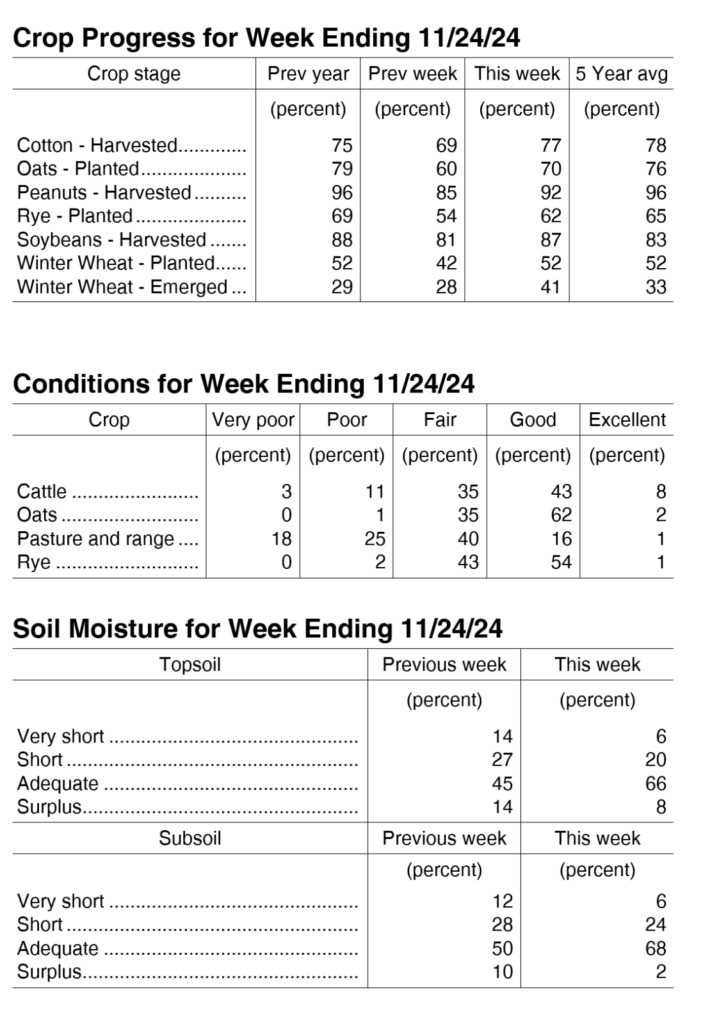The Colqiutt County Extension office would like to wish everybody a Happy Thanksgiving. We will close at 1 PM on Wednesday, November 27, 2024, and reopen on Monday, December 2, 2024.
The last weeks drought monitor is below. It shows that 36% of Georgia is not experiencing drought conditions.

Crop Progress report was released on November 25, 2024 and some of the data is shown below. The most current report is available here.

Cold weather is in the forecast next week and according to Dr. Bob Kemerait, UGA Plant Pathologist, this will hopefully kill volunteer peanuts, volunteer corn, and regrowth on cotton. While it will not be cool enough long enough to kill the cotton plants, cooler soils should help to slow development and reproduction in the plant-parasitic nematodes affecting all crops. Killing volunteer corn and peanuts will help to reduce development of tar spot and leaf spot diseases, though the pathogens will remain in the crop debris as an inoculum source for the 2025 crop season. Spores for rust diseases (Southern corn rust, peanut rust, soybean rust) all will not survive our winter without a living host. However, peanut leaf spot pathogens, tar spot pathogen, cotton target spot pathogen, and Rhizoctonia will over-winter in crop debris. Weather or practices of field sanitation that hasten the rot of the crop debris helps to reduce the threat of these diseases next season.
A hard freeze appears likely early next week in the Southeast, including southern Georgia, Alabama, and northern Florida. https://www.cpc.ncep.noaa.gov/
When can I start grazing my winter annual forages? This is one of the most frequent errors made when cool season annuals are utilized. In fact, many farms over seed bermudagrass with rye or ryegrass and never remove the cattle. Allowing plants to develop a root system will improve drought tolerance and improve forage production over the long term. Delay grazing cool season annuals until they reach 6-8” in height and try not to graze plants shorter than 2-3”. The plants will survive if they are grazed too early, but they will never fully recover. Research conducted by Drs. Gary Hill and Dennis Hancock in Athens and Tifton suggests that starting to graze too early (i.e., at ~4 in.) reduces the total forage yield in the season by at least one third.
How do I fertilize my winter annuals? Apply 40 – 50 lbs of N per acre at planting or soon after the plants emerge to increase growth, tillering (thickening of the stand), and provide earlier grazing. A second application of 40 – 50 lbs of N per acre should be applied in mid-winter to increase winter and spring forage production. Because ryegrass is longer-lived, a third application of 40 – 50 lbs of N per acre may be needed in early spring when ryegrass is used for late spring grazing, hay, or silage crop. Rates of N in excess of these amounts may result in substantial N losses to leaching and excessive growth during the winter. Fresh, tender growth that occurs when nitrogen is in excess could be damaged by extremely cold weather.
I have a bunch of weeds in my winter grazing, do we have any weed control options in winter annual forages? Yes, there are several options for weed control in winter annual forages. Options include 2,4-D, dicamba, Harmony Extra and other tank-mix products. The information below is from the UGA Pest Management Handbook.
2,4-d and dicamba products need to be applied in December, January or February to control swinecress, blessed thistle, wild garlic, curly dock and similar winter weeds after small grain tillering but before jointing. Grazing restrictions may vary among the different 2,4-D products. Several 2,4-D labels restrict grazing for dairy animals or meat animals being finished for slaughter for 14 days after treatment. For Banvel, restrict grazing for lactating dairy animals for 7 days after treatment and remove meat animals
from treated areas 30 days prior to slaughter. For Banvel, there is no waiting period between treatment and grazing for non-lactating animals. Refer to specific herbicide label for additional use information.
Weedmaster is another option according to the pest management handbook. Apply to emerged broadleaf weeds when crop has 2–4 tillers. Do not graze lactating dairy animals within 7 days. There is no restriction between application and grazing for non-lactating animals. Do not cut for hay within 37 days after treatment. Do not graze meat animals in treated areas within 30 days of slaughter. Weedmaster and Outlaw will severely injure or kill clovers or alfalfa.
Harmony Extra is another option. Apply after two-leaf stage of wheat, barley, triticale and oats but prior to flag leaf being visible. Harmony Extra SG is not recommended for use on ryegrass or rye. Most winter annuals can be controlled with 0.45–0.6 oz/A; however, 0.75–0.9 oz/A is recommended for controlling wild garlic or small wild radish. Add 1 qt of non-ionic surfactant per 100 gal of spray solution. For best results, apply when weeds are in the 2–4 leaf stage, temperatures are above 50° F, and not drought stressed. Liquid nitrogen may be used as the carrier. When using nitrogen as the carrier, reduce surfactant rate to 0.5–1 pt/100 gal of solution (wheat burn may still be noted). May also tank mix Harmony Extra SG with 0.25–0.375 lb ai/A of 2,4-D or MCPA for improved control of wild radish. Do not use surfactant if Harmony Extra SG and 2,4-D or MCPA are applied in nitrogen. Do not graze within 7 days of application. This grazing restriction applies to all types of livestock. Allow at least 30 days between application and feeding of hay from treated areas to livestock.
Dr. Eric Prostko, UGA Weed Specialist, wanted to make everybody aware that Corteva will be hosting several Enlist® training meetings in AL, GA, and SC the first week of December. Topics to be covered include tank-mixing, nozzle selection, sprayer cleanout, weather, and field planning.
Source : uga.edu